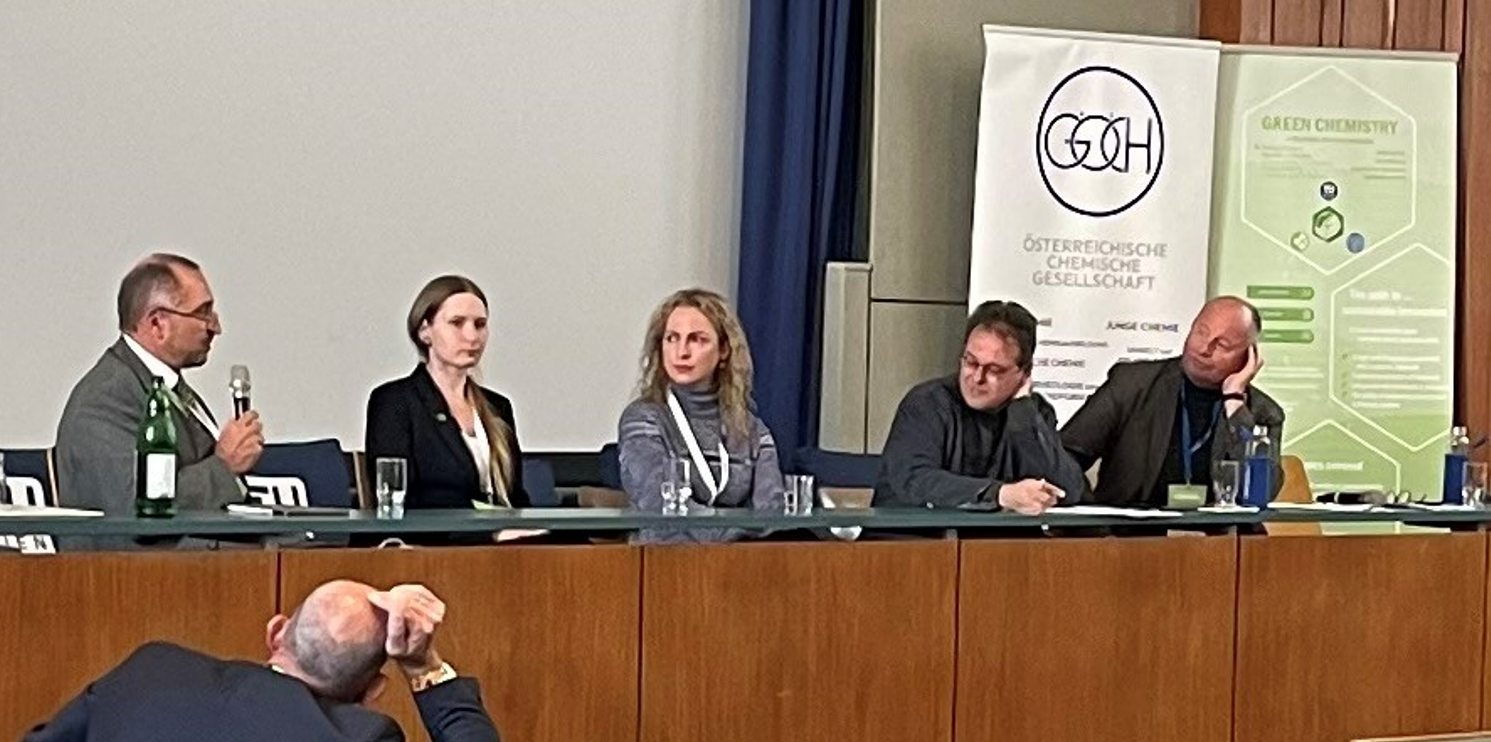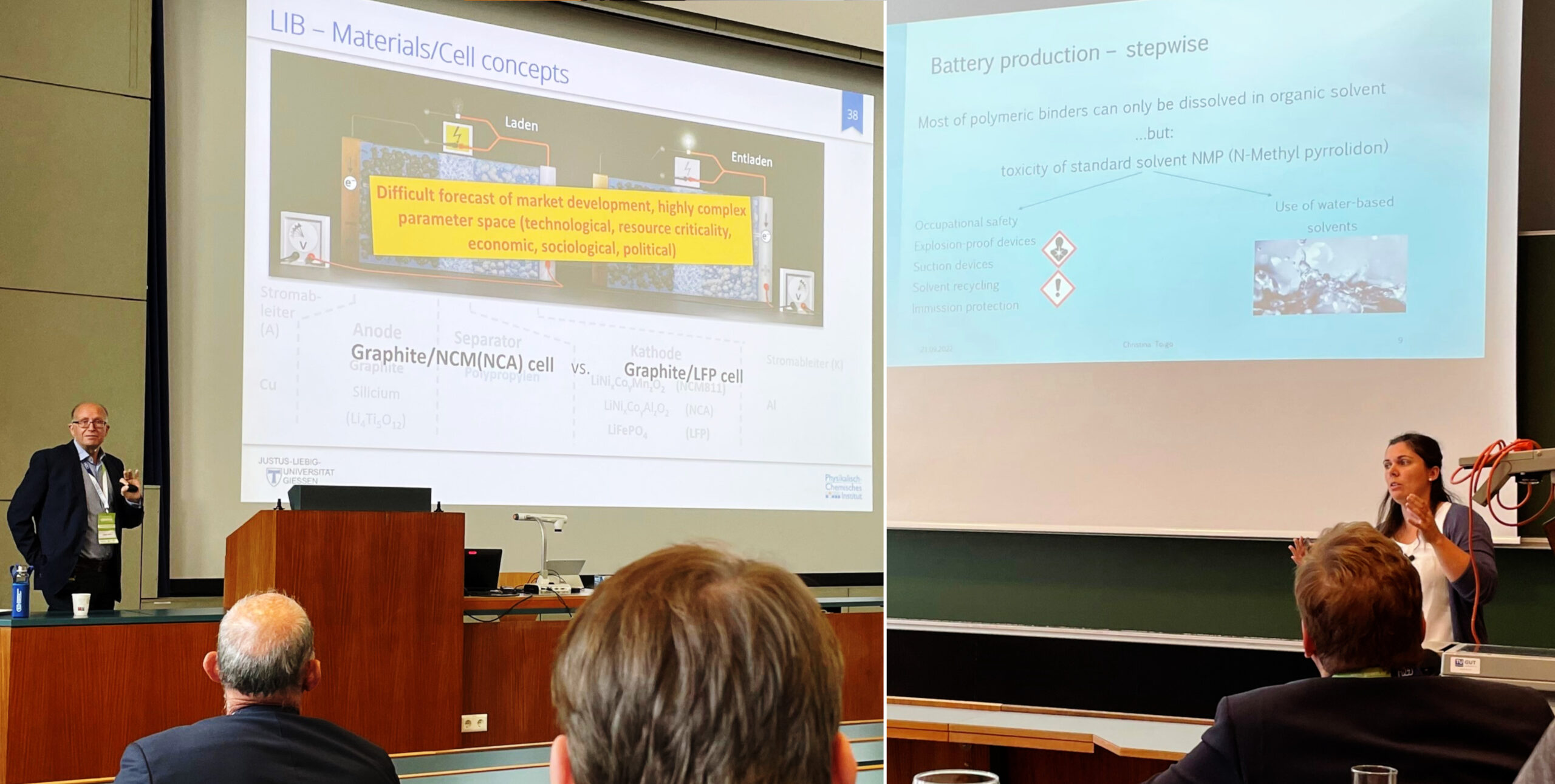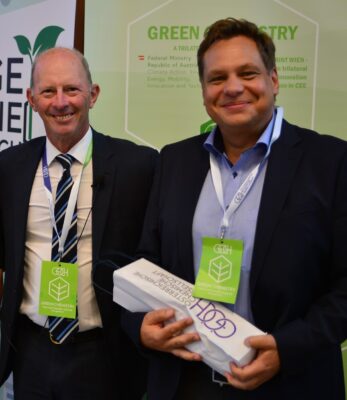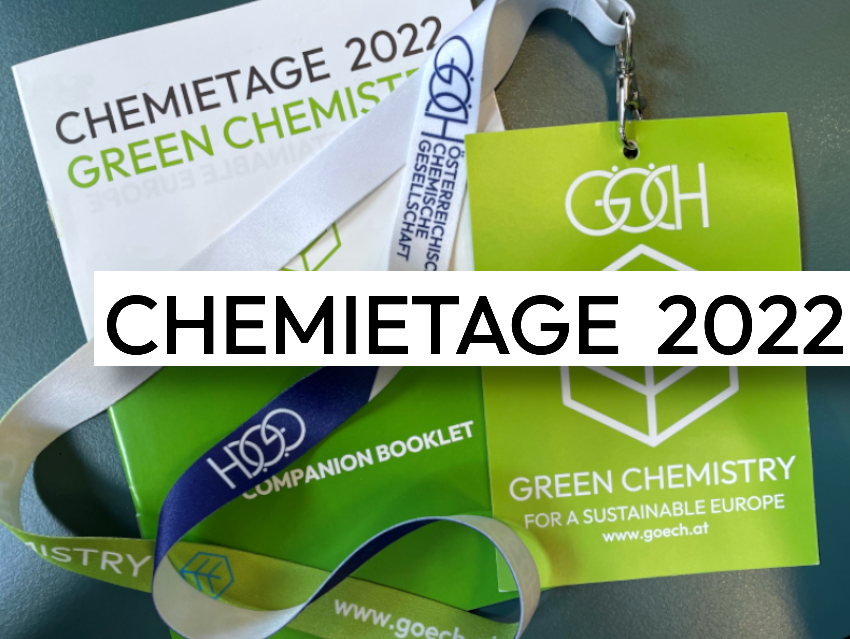Vienna is the city of Art Nouveau and music, imperial city and an innovative modern metropolis, famous for its coffee house culture and cuisine. But Vienna is also—and this is perhaps much more interesting for chemists—the place where 125 years ago, following a trend of the time, the GÖCH, the Austrian Chemical Society, was founded and where the GÖCH hosted the Austrian Chemistry Days at the end of September.
The Austrian Chemistry Days are well-known and popular as a biennial intensive exchange between chemists from university and industry, between younger and established chemists, mainly from Austria, but also from neighboring countries such as Germany, Switzerland, or Slovakia. This event had to be canceled in 2021 due to the coronavirus pandemic and could now, finally, be made up for at TU Vienna.
TU Vienna is located right next to the lively Karlsplatz with the Karlskirche (St. Charles Church), one of the most important baroque churches north of the Alps.
 Karlskirche und one of the Otto Wagner Pavilions with the Café-Restaurant Karl Otto and Club U at Karlsplatz.
Karlskirche und one of the Otto Wagner Pavilions with the Café-Restaurant Karl Otto and Club U at Karlsplatz.
A new team in the GÖCH office, together with colleagues from TU Vienna, organized an exciting conference with a lot of enthusiasm. I was particularly impressed by the fact that the young participants also took a very active part in the discussions.
The central theme of the Austrian Chemistry Days this year was “Green Chemistry for a Sustainable Europe”. Accordingly, the keynote lectures and many of the posters and other presentations dealt with topics such as sustainable feedstocks, carbon capture, power-to-X technologies, catalytic transformation of CO2, circular economy, carbon2product (C2PAT), energy storage, sustainable batteries, or the Green Deal. There was a panel discussion on green chemistry and a start-up session that offered examples and opportunities to ask questions about how to bring one’s research to market. Of course, one of the pressing questions is how chemists can contribute their solutions. We need new ideas, innovations, and strong progress.

Walter Schneider, Head of the GÖCH Office, participants, and registration and handing out the conference bags. Middle photo: © W. Schneider
Panel on Green Chemistry in Europe
The participants of the panel discussion (Ing. Hubert Culik, President of the FCIO (Austrian Economic Chamber), Dr. Thomas Jakl, Deputy Director General of the Austrian Ministry of the Environment, responsible for chemicals policy, Sarah Keck, representative of the Young Chemists Forum (JC) of GÖCH and a Ph.D. student at TU Wien, Dr. Ganna Lyashenko, Deputy Editor at Chemistry – A European Journal, and Professor Marko Mihovilovic, Dean of the Faculty for Technical Chemistry, TU Wien) all agreed that it is a must to change now and for this, a change management process must take place in our heads.
We cannot win the fight against climate change without chemistry. Fridays for Future is very important for raising awareness, but they have no real answers. Chemistry can and must provide them. We as chemists need to see ourselves as facilitators and translators into the social discussion.
In Europe, we have to be careful not to lose the momentum, one of the panel participants said. The momentum is currently much higher in the US. Also, greenwashing is seen as another danger. The EU Commission has just published a guide on how to avoid greenwashing. Chemistry loses its credibility when it engages in greenwashing, warned one of the panelists, quite rightly.

From left to right: Professor Marko Mihovilovic, Dean of the Faculty for Technical Chemistry, TU Wien, Sarah Keck, representative of the JC of the GÖCH and Ph.D. student at TU Wien, Dr. Ganna Lyashenko, Senior Associate Editor Chemistry – A European Journal, the moderator Martin Kugler, Science Communication at AIT Austrian Institute of Technology GmbH, Vienna, Dr. Thomas Jakl, Deputy Director General of the Austrian Environment Ministry, responsible for chemicals policy.
Selected Talks
What is the Battery of the Future?
Jürgen Janek, Professor at the Justus Liebig University Gießen, Germany, and his team investigate physicochemical fundamentals of solid-state processes that are important for energy and interface technologies. He began his talk by quoting from Germany’s largest news website: “Electrochemistry is the crispbread among the natural sciences: hard, dry, not glamorous. But it will radically change mobility and thus our lives—for example, with the car battery of the future [1].”
Electromobility is an important pillar for sustainable mobility in the future. The automotive sector is the driving force in the technological development and optimization of batteries. However, batteries are also needed in many other mobile and stationary applications, such as in robots or as storage for electricity generated from wind or solar power. This makes batteries indispensable devices at different scales and in different environments and drives research.
Jürgen Janek calculated as an example that about 3.8 TWh (3800 GWh) per year would be needed if all car traffic in Germany was converted to electricity. Currently, Germany generates about 600 TWh of electricity per year, and Tesla’s Gigafactories produce about 20 GWh each. This means that a whole series of gigafactories will be needed to meet global demand.
Li-ion batteries (LIBs) are currently the dominant technology. 70 % of global cell production is in China. Now, the original equipment manufacturers (OEMs) cannot obtain the required number of LIB cells, as the demand for materials resources cannot be covered. The market is extremely tight and is still in the development phase. This necessitates stretching resources through smaller batteries with shorter ranges, as well as the rapid establishment of recycled cells, and less resource-critical cell concepts. Another option could be reducing the number of cars and their total range per year.
So, the transformation of the mobility sector is a major task for chemistry. Batteries are a research topic for virtually every area of chemistry, not just electrochemistry. Questions arise such as: Is there anything other than LIBs? Can other cell chemistries such as Na-ion batteries, Mg-ion batteries, Li-sulfur batteries, or Li-oxygen batteries compete with LIBs? Can LIBs still be improved? Will solid-state LIBs be a significant improvement? Or hybrid concepts?
Jürgen Janek reports enormous progress in the fundamental understanding of lithium-oxygen (Li/O2) cells [2,3]. Other metal-oxygen (Me/O2) batteries (Me = Al, Na, Si, Mg, …) are also being studied in parallel. However, their performance is still far from the requirements of practical systems. Stable rechargeable metal-oxygen batteries with high capacity are, therefore, not in sight. Major challenges in materials include redox-stable electrolytes, Me anodes, singlet O2, and better mechanistic understanding.
Jürgen Janek estimates that LiBs will continue to dominate initially, as excellent performance is already being achieved. Lithium metal batteries with solid electrolytes are considered the next generation of lithium batteries due to their higher energy density and safety. While current LIBs are based on liquid electrolytes, solid-state batteries (SSBs) are based on solid electrolytes (SEs) and promise improvements in several key performance indicators. However, interfacial instabilities between Li metal and solid electrolytes limit their application in practical batteries so far [4,5].

Talks of Jürgen Janek und Christina Toigo.
Water-Based Binder for Battery Electrodes
Christina Toigo, Professor at the FH Wels, Austria, and her team are also involved in sustainable battery research. The spinel Li4Ti5O12 (LTO) is an attractive alternative to the commonly used graphite anodes. Graphite can be mined as natural graphite or produced synthetically via a coke-based process. Both have a significant environmental footprint. LTO features high cycling stability, fast kinetics, and high rate capability. The relatively high lithium insertion voltage of 1.55 V compared to Li/Li+ prevents the electrochemical formation of a solid electrolyte interphase (SEI) from ethylene carbonate reduction. However, LTO has low electrical conductivity and a low Li-ion diffusion coefficient. To overcome this, Christina Toigo is experimenting, for example, with modifying the current collector to improve contact with the active material to reduce overall resistance, or with the binder.
Binders are used to keep the active material of the electrode particles together and in contact with the current collectors, i.e., an aluminum foil or a copper foil. Binders influence the morphology, adhesion, and electrochemical properties of LTO electrodes. Standard synthetic binders are polyvinylidene fluoride (PVDF), polytetrafluoroethylene (PTFE), or styrene-butadiene rubber (SBR). Replacing those mostly fluorinated polymers with natural polymers that are sustainable, biodegradable, and non-toxic is of interest.
Christina Toigo presented studies on combining LTO with sodium alginate (SA) as a binder [6]. SA is a linear copolymer consisting of β-D-mannuronic acid and α-L-guluronic acid monomers linked by a β-(1-4)-glycosidic bond. It is usually obtained in the form of sodium salt from brown algae and is non-toxic, highly available, and cheap. Its good gelling capacity, stabilizing properties, and high viscosity in water make it an attractive candidate for a wide range of applications, for example, as food additive E401.
A crucial property of a slurry is its optimal rheological behavior for the casting process onto the current collector. Christina Toigo found that adjusting the slurries with two different surfactants (a polymeric fluorochemical and an ammonium salt in water) improves their stability and viscosity, compared with surfactant-free slurry. This is caused by the disentanglement of the polymer chains.
In general, the electrochemical performance was promising, and so SA may make it possible to replace the solvent-based process with a water-based process. The research is still ongoing.
125 Years of GÖCH
The Beginning
On June 24, 2022, the GÖCH celebrated its 125th anniversary at an event at the TU Wien in Vienna. The event looked back to June 18, 1897, when the first constituent meeting of the then Verein Österreichischer Chemiker (Association of Austrian Chemists) was held in Vienna.
The idea in 1897 was to have a non-political representative body for Austrian chemists. There were already individual associations in Austria, but there was no real professional representation and not one voice for all chemists in the county [7,8]. Similar efforts existed in other countries at that time: The oldest chemical society, the British Chemical Society, a precursor of the Royal Society of Chemistry (RSC), was founded in 1841 in London. The German Chemical Society (or Deutsche Chemische Gesellschaft (DChG), a precursor of the GDCh (German Chemical Society), was founded in 1867 in Berlin, the Swiss Chemical Society (SCG) in 1901, and the Società Chimica Italiana (SCI) in 1909, to just name a few chemical societies from neighboring European countries.
The constituent meeting in 1897 of the “Association of Austrian Chemists in Vienna” was attended by 25 chemists. However, about 150 more had already announced that they wanted to join, and the number quickly grew to 500. Today, the GÖCH has about 2,000 members.
In 1901, the name was changed to “Verein Österreichischer Chemiker” (VÖCH) to show that Austrian chemists who were not from Vienna were also welcome in the association. In 1982, the association was renamed “Gesellschaft Österreichischer Chemiker” (GÖCH, Society of Austrian Chemists). In January 2022, the name was changed to “Österreichische Chemische Gesellschaft” (Austrian Chemical Society). However, the acronym GÖCH will be retained for the time being, according to the results of a survey among the members.
Famous Austrian Chemists
Among the famous chemists from Austria is Josef Loschmidt who was born in Putschirn, Bohemia, in 1821 and died in Vienna in 1895, and who conducted research in the fields of thermodynamics, electrodynamics, and optics and on crystal forms. After him the Loschmidt constant is named.
Carl Freiherr Auer von Welsbach was born in Vienna in 1858 and died in Mölbling, Carinthia, in 1929, and discovered the elements neodymium, praseodymium, ytterbium, and lutetium, invented the incandescent mantle in the gaslight (“Auerlicht”), the metal filament lamp, and the igniter (“Auermetall”) in the lighter, and is the creator of the Osram brand.
Friedrich Emich was born in Graz in 1860 and died in Graz in 1940, and, together with Nobel Prize winner Fritz Pregl of the University of Graz, Austria, is known as the founder of microchemistry. Fritz Pregl was born in 1869 in Laibach, Austria-Hungary, today Ljubljana in Slovenia, and died in 1930 in Graz. He won the Nobel Prize in Chemistry in 1923 “for his invention of the method of micro-analysis of organic substances” [9].
Publications
Together with 15 other European chemical societies, united under the name Chemistry Europe, GÖCH publishes 19 international journals and the magazine ChemistryViews. Together with the Austrian Academy of Sciences, it publishes the scientific journal Monatshefte für Chemie – Chemical Monthly [10]. GÖCH members regularly receive the Nachrichten aus der Chemie, the monthly membership magazine of the GDCh which includes quarterly contributions from GÖCH.
Conclusions
Peter Gärtner, the president of the GÖCH and a professor at TU Wien, summed up at the end of the Chemistry Days that looking at sustainable developments the “bad thing is that everything is changing only very slowly. The good thing, especially for the younger scientists, is that chemists don’t have to worry about their positions; there’s plenty left to do and research.” One main message, he concluded, is that we need to move from a linear to a circular economy and waste is no longer waste but the starting material of the future. Products and materials need to be thought and designed accordingly. As we all know, we have to change our processes, make sure that we do not have too much impact on Nature, and reduce CO2 production. In total, Europeans are going in the right direction, but, as said, too slowly.
For me, it was an inspiring event with many good conversations and discussions. What remains is the wish that Green Chemistry in Europe will progress even faster and more innovatively through research and development.

Peter Gärtner, Professor at TU Wien, and Oliver Diwald, Professor at Paris-Lodron University Salzburg (photo: © W. Schneider)
The next Austrian Chemical Days will take place in Leoben, Austria, in September 2024.
References
[1] Jürgen Pander, Warten auf den Wunder-Akku, Spiegel Online March 22, 2018. (accessed October 6, 2022)
[2] Philipp Adelhelm, Pascal Hartmann, Conrad L. Bender, Martin Busche, Christine Eufinger, Jürgen Janek, From lithium to sodium: cell chemistry of room temperature sodium–air and sodium–sulfur batteries, Beilstein J. Nanotechnol. 2015, 6, 1016–1055. https://doi.org/10.3762/bjnano.6.105
[3] Conrad L. Bender, Daniel Schröder, Ricardo Pinedo, Philipp Adelhelm, Jürgen Janek, One- or Two-Electron Transfer? The Ambiguous Nature of the Discharge Products in Sodium–Oxygen Batteries, Angew. Chem. Int. Ed. 2016. https://doi.org/10.1002/anie.201510856
[4] Solid-State Battery Roadmap 2035+, Fraunhofer ISI April 2022.
[5] Jürgen Janek, Wolfgang A. Zeier, solid future for battery development, Nat. Energy 2016, 1, 16141. https://doi.org/10.1038/nenergy.2016.141
[6] Christina Toigo, Milan Kracalik, Elke Bradt, Karl-Heinz Pettinger, Catia Arbizzani, Rheological Properties of Aqueous Sodium Alginate Slurries for LTO Battery Electrodes, Polymers 2021, 13(20), 3582. https://doi.org/10.3390/polym13203582
[7] Walter Schneider, Interview mit Chemiehistoriker Rudolf Werner Soukup, Nachr. Chem. 2022, 93–94. https://doi.org/10.1002/nadc.20224129843
[8] Peter Gärtner, 125 Jahre GÖCH, Nachr. Chem. 2022, 92. https://doi.org/10.1002/nadc.20224129841
[9] NobelPrize.org
[10] GÖCH homepage
Also of Interest
 Interview: Bringing Other Voices into the Discussion
Interview: Bringing Other Voices into the Discussion
Peter Gärtner, President of the Austrian Chemical Society, on generally understandable explanations in chemistry and research in the field of doping


